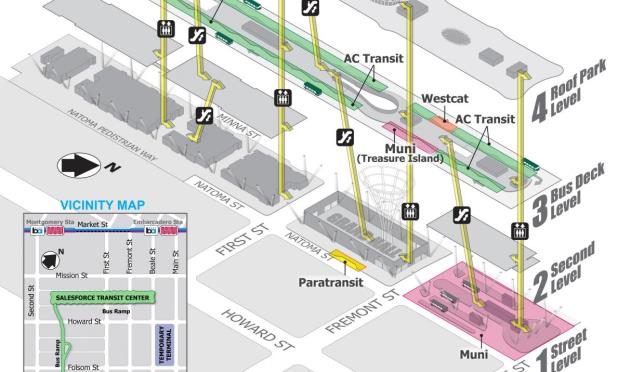 The levels of the transit center show the location of the main floor, bus deck and roof park.
The levels of the transit center show the location of the main floor, bus deck and roof park.
SAN FRANCISCO—The Salesforce Transit Center is being touted as the Grand Central Station of the West as it centralizes the region's transportation network. It will help ease traffic congestion, reduce pollution, and make transit more accessible and efficient for Bay Area commuters, especially in the rapidly growing South of Market neighborhood.
The development has a bridge crossing several busy streets to provide direct bus access from the Bay Bridge to the transit center, reducing congestion and improving travel times.
The transit center began serving AC Transit, Greyhound, and other state and regional bus operators this past weekend. MUNI began operating out of the bus plaza or street level in June 2018.
The transit center will connect all points in the Bay Area for more than 100,000 passengers per day. It will provide transportation links to eight Northern California counties including San Francisco, San Mateo, Sonoma, Napa, Marin, Santa Clara, Contra Costa and Alameda as well as connection to the entire state.
It will serve transit agencies such as AC Transit, Caltrain, MUNI, Golden Gate Transit, SamTrans, Amtrak, WestCAT Lynx, Greyhound, Paratransit and high-speed rail with connections to BART and MUNI Metro. Phase one of the project connects the bus services of AC Transit and WestCAT from the East Bay, and Greyhound and Amtrak Thruway bus service with Muni service in San Francisco.
Phase Two of the project will bring Caltrain service from the Peninsula and eventually California high-speed rail trains from Southern California into an underground station with three platforms and six tracks. This will allow travel between San Francisco and Los Angeles in less than 2-1/2 hours and provide seamless connections between all of Northern California.
“The train box on the bottom level is waiting for funding,” an AC Transit rep tells GlobeSt.com. “They would need to bore a tunnel from AT&T Park for trains to be accessible to this station. As for timing, I would only be speculating.”
The multi-level building (four stories above grade and two below) includes a rooftop public park, retail space, bicycle parking and administrative offices. The design has a two-block-long bus deck with 37 bus bays providing direct freeway access for AC Transit, WestCAT, Amtrak Thruway, Greyhound buses, MUNI service to Treasure Island (25) and a ground-level bus plaza serving six major MUNI lines (5/5R, 7 and 38/38R). The transit center will be the terminus for the Muni 5, 5R, 7, 38 and 38R routes at the bus plaza and the 25 on the bus deck. Double decker buses will come later this year as part of Transbay Tomorrow, GlobeSt.com learns.
Ancillary projects include a public plaza on Mission Street, west of Fremont Street and the Salesforce Tower off of Mission Street, east of First Street.
The Transbay Joint Powers Authority manages and operates the Salesforce Transit Center. As a partner agency, SFMTA provided technical support and design input for the project with transit power infrastructure for MUNI buses and the design of the street level bus plaza. SFMTA traffic engineering has and will continue to help guide construction on city streets for necessary utility relocations and construction of the below-grade train box. Funding for the project is provided through TJPA and includes federal grants, proceeds from the sale of state property in the area, loans and local sources.
While construction of the new Salesforce Transit Center took place, a temporary Transbay Terminal served MUNI and AC Transit for eight years.
The national average rent in transit-accessible office buildings was 65% higher than the average market rent in early 2018, Transwestern reports in an analysis of mass transit's influence on the office market. The examination of 15 major metros shows average rent in Central Business Districts was $43.48 per square foot NNN for transit-accessible buildings versus $26.01 per square foot NNN for car-dependent buildings. Transit-accessible office space was also at a premium in the suburbs, with average rent of $33.43 per square foot NNN being nearly 50% higher than rent in car-dependent buildings.
Want to continue reading?
Become a Free ALM Digital Reader.
Once you are an ALM Digital Member, you’ll receive:
- Breaking commercial real estate news and analysis, on-site and via our newsletters and custom alerts
- Educational webcasts, white papers, and ebooks from industry thought leaders
- Critical coverage of the property casualty insurance and financial advisory markets on our other ALM sites, PropertyCasualty360 and ThinkAdvisor
Already have an account? Sign In Now
*May exclude premium content© 2025 ALM Global, LLC, All Rights Reserved. Request academic re-use from www.copyright.com. All other uses, submit a request to [email protected]. For more information visit Asset & Logo Licensing.








